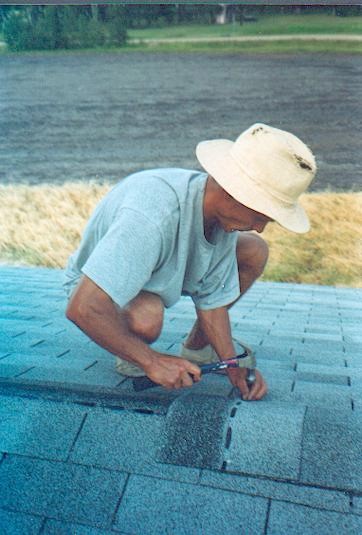
Roofing

Slope effect
For the slopes steeper than 4 in 12 an adhesive waterproofing membrane need only be applied along the edges of a roof to protect eaves in spring when some snow may direct water upwards and under the shingles. If it wasn't expensive, I would have covered the entire roof with it.
A fascia board and the edge trim that directs rain water into gutters were installed first, of course.
Another effect of the slope being 5 in 12 and the house being 23 to 28 feet high was that working along roof edges was a risky business. All material including OSB, GripGuard, felt and shingles are slippery even when dry. It was important to use the proper boots. Working barefoot was ok too. I had to wait for morning dew to dry up though.
Felt underlay
The felt underlay was required. Failure to apply it over the entire roof would have broken the shingles 20 year manufacture warranty.
Shingles
I bought the shingles in Revy as getting a rental truck there had always been very convenient. Most shingle distributors had offered a roof delivery but for some reason I didn't trust them that much. I was afraid that unloading a bunch of heavy bundles in one place might indeed have broken my roof as it was not designed for such concentrated load.
So I ended up lifting all the heavy packages on the roof manually. It was not a bad exercise for a couple of days.
Protective film
The standard three-tab ashphalt shingles come with a protective tape on the underside of them to protect them from sticking together in a package. Contractors never remove it. I had made a simple experiment and applied two shingles side by side, one with the protective tape removed and another with the tape intact. After couple of hot days, the one with the tape did not stick at all but the other one with the tape removed stuck just fine. Therefore, I decided to remove this tape from each shingle despite that the roofing contractors were laughing at me.

Cementing
As an extra protection against strong winds that had been normal in my place, besides nailing the shingles down, I glued each tab in each shingle with roofing cement.
Valleys
The valleys were reinforced with a sheet metal according to the Code.
Nailing
As you see on the picture to the right, I used just a hammer. After little practicing I was able to nail shingles at a rate of one nail per second. A pneumatic gun could probably do faster than that but again labour was free in my case. Why pay extra for the expensive tools?
Real test
The real test of my quality roofing was of course, the wind storm in fall of 2004. The wind was gusting to 110 km per hour and many neighboring bungalows had their shingles torn off. I didn't loose a single one on my two storey house.
